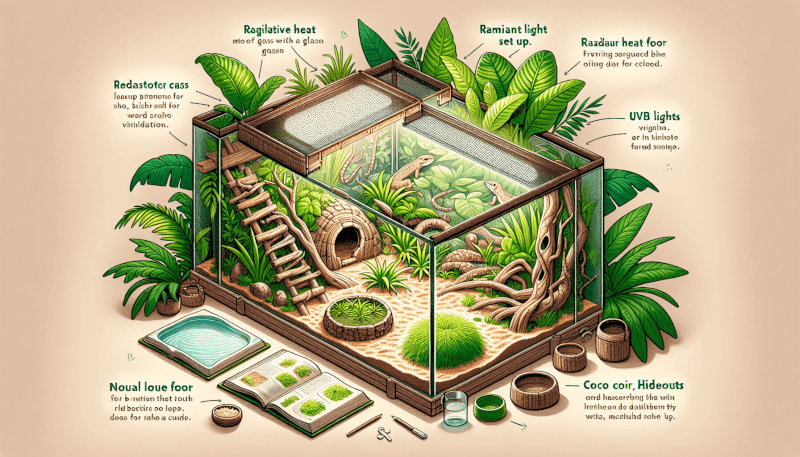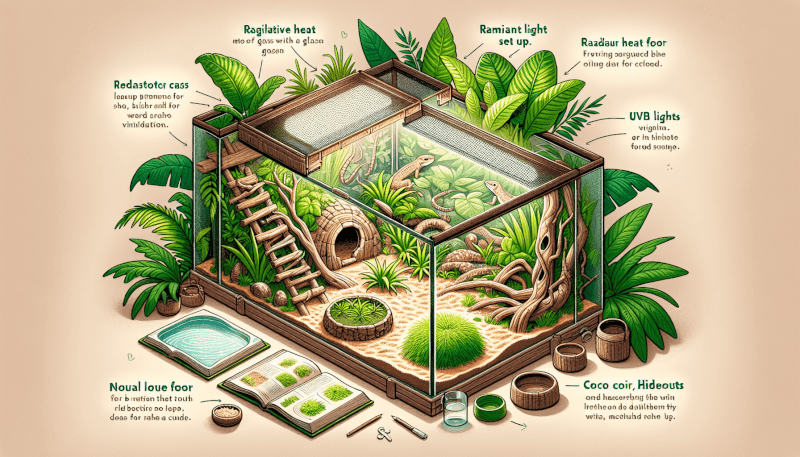Are you considering getting a reptile as a pet? Creating an ideal habitat is crucial for the health and well-being of your scaly friend. In this article, we will guide you through the essential steps of setting up a reptile habitat, from choosing the right enclosure to creating the perfect environment. Whether you are a first-time reptile owner or looking to upgrade your current setup, this guide is here to help you create a safe and comfortable home for your cold-blooded companion. So, let’s jump in and explore the fascinating world of reptile habitats together!

Choosing the Right Reptile
When it comes to choosing a reptile as a pet, thorough research is essential. Take the time to consider different reptile species, their specific needs, and their compatibility with your lifestyle and preferences.
Researching Different Reptile Species
Start by researching and learning about various reptile species. Each species has its own unique characteristics, requirements, and temperaments. Consider factors such as size, lifespan, diet, and activity level when deciding on the right reptile for you.
Evaluating Reptile Size and Lifespan
Consider the size and lifespan of the reptile species you are interested in. Some reptiles, like turtles or tortoises, can grow quite large and require spacious enclosures. Others, like geckos or certain snakes, remain relatively small. Make sure you have enough space to comfortably accommodate the reptile’s adult size and be prepared for the commitment of caring for it throughout its lifespan.
Considering Reptile Activity Level
Different reptile species exhibit varying levels of activity. Some reptiles, like bearded dragons or monitor lizards, are highly active and require ample space to roam and explore. Others, like ball pythons or leopard geckos, are more sedentary. Consider your own preferences and lifestyle when choosing a reptile with a suitable activity level.
Determining the Reptile’s Housing Requirements
Understanding the specific housing needs of your chosen reptile is crucial for their overall health and well-being. Consider factors such as the reptile’s natural habitat, temperature requirements, and humidity levels.
Understanding the Natural Habitat of the Reptile
Research the natural habitat of the reptile species you will be keeping. Native environments can provide valuable insights into the reptile’s specific needs. For example, desert-dwelling reptiles require a dry and warm environment, while tropical reptiles need higher humidity levels.
Considering the Reptile’s Temperature Needs
Reptiles rely on external heat sources to regulate their body temperature. Research the ideal temperature range for your chosen reptile species and provide a suitable heating setup within their enclosure. This may include using heat lamps, heating pads, or ceramic heat emitters.
Creating the Right Humidity Level for the Reptile
Humidity levels are crucial for reptiles that require specific moisture in their environment. Some reptiles, such as chameleons or tree frogs, thrive in high humidity, while others, like desert-dwelling reptiles, require low humidity. Invest in a hygrometer to measure and maintain the appropriate humidity levels for your reptile’s health.

Preparing the Reptile Enclosure
Before bringing your reptile home, ensure their enclosure is properly prepared and set up to meet their needs. Consider factors such as enclosure size, material, and security.
Selecting an Appropriate Enclosure Size
Provide ample space for your reptile to move around comfortably. Consider the adult size of your reptile species and choose an enclosure that allows for growth. Keep in mind that certain reptiles, like arboreal species, may require vertically-oriented enclosures for climbing.
Choosing the Right Enclosure Material
Decide on a suitable material for your reptile’s enclosure. Glass enclosures are commonly used and provide good visibility, while plastic or PVC enclosures are lighter and easier to clean. Make sure the materials used are non-toxic and safe for your reptile.
Setting Up a Secure Enclosure
Ensure that your reptile’s enclosure is secure and escape-proof. Reptiles have a knack for finding weaknesses, so be sure to check for any gaps, loose fittings, or openings that could allow them to escape. Keep in mind the specific needs and behaviors of your reptile species when adding locks, screens, or other security measures.
Setting Up the Substrate
The substrate, or flooring material, in your reptile’s enclosure plays a crucial role in maintaining their health and comfort. Consider factors such as substrate type, cleanliness, and maintenance requirements.
Researching Reptile Substrates
Different reptile species have specific substrate preferences. Some reptiles, like bearded dragons or leopard geckos, do well with sand or reptile carpet. Others, like snakes or monitor lizards, prefer natural substrates such as aspen shavings or coconut husk. Research the appropriate substrate for your reptile and provide a suitable flooring option.
Considering Substrate Cleanliness and Maintenance
Regular cleaning and maintenance of the substrate is important to prevent the buildup of bacteria or parasites. Some substrates may require more frequent cleaning or replacement than others. Consider factors such as ease of cleaning, absorbency, and odor control when selecting and maintaining the substrate in your reptile’s enclosure.

Installing Proper Lighting and Heating
Proper lighting and heating are essential for reptiles to thrive. Understanding the specific lighting and heating requirements of your chosen reptile ensures their overall health and well-being.
Understanding the Reptile’s Light Requirements
Reptiles require specific wavelengths of light to aid in their digestion, calcium metabolism, and overall well-being. Research the appropriate lighting setup for your reptile species, including the use of full-spectrum UVB bulbs or heat lamps. Ensure that the lighting schedule mimics their natural day and night cycles.
Choosing the Right Heat Source
Provide a suitable heat source to maintain the reptile’s overall body temperature. Reptiles may require basking spots with higher temperatures, as well as cooler areas within the enclosure for thermoregulation. Use thermostats or temperature controllers to maintain a consistent and safe heat source.
Placing Lighting and Heating Equipment in the Enclosure
Position lighting and heating equipment strategically within the enclosure. Consider the reptile’s specific needs and behaviors to ensure they can access the heat and light sources easily. Avoid placing equipment too close to the reptile’s favorite resting spots to prevent burns or discomfort.
Providing an Adequate Water Source
Water is vital for the hydration and health of your reptile. Understanding their specific drinking habits and providing them with a suitable water dish or bowl ensures their well-being.
Determining the Reptile’s Drinking Habits
Research the drinking habits of your reptile species. Some reptiles, like tortoises or chameleons, enjoy soaking in shallow water dishes, while others, like snakes or geckos, prefer dripping water or misting. Observe your reptile’s preferences and provide water in a way that best suits their natural behavior.
Selecting the Right Water Dish or Bowl
Choose an appropriate water dish or bowl that accommodates the size and needs of your reptile. Provide a shallow dish for reptiles that enjoy soaking, while keeping water levels low for reptiles that prefer just a small amount of water. Clean and replenish the water regularly to ensure its freshness and prevent contamination.

Creating Hiding Spots and Climbing Structures
Reptiles need hiding spots and climbing structures to feel secure and engage in natural behaviors. Research the specific preferences of your chosen reptile and provide suitable hides and climbing opportunities.
Researching Reptile Hiding and Climbing Preferences
Different reptile species have varying hiding and climbing preferences. Some reptiles, like snakes or tarantulas, appreciate snug hides or burrows. Others, like geckos or tree frogs, thrive with vertical climbing structures. Research your reptile’s species-specific preferences and provide appropriate options.
Adding Suitable Hides and Caves
Incorporate hides and caves within the enclosure to give your reptile a sense of security. These hiding spots should be placed strategically throughout the enclosure to provide your reptile with options and mimic their natural behavior. Ensure that the hides are appropriately sized for your reptile to comfortably fit in.
Incorporating Various Climbing Structures
If your reptile species enjoys climbing, incorporate appropriate climbing structures. This can include branches, vines, or rocks that provide horizontal and vertical climbing opportunities. Research the load-bearing capacity of the enclosure to ensure the safety of your reptile and avoid any potential accidents.
Selecting and Arranging Decorations
Decorations not only enhance the aesthetic appeal of the enclosure but also provide enrichment for your reptile. Consider natural or artificial decorations, such as plants and branches, and arrange them in a way that suits your reptile’s needs and preferences.
Choosing Natural or Artificial Decorations
Decide whether natural or artificial decorations are the best fit for your reptile’s enclosure. Natural decorations, such as live plants or driftwood, can provide environmental enrichment and a more authentic aesthetic. Artificial decorations, like resin caves or fake plants, offer easy cleaning and maintenance options. Consider the specific needs and behaviors of your reptile when choosing between natural or artificial decorations.
Incorporating Plants and Branches
For reptiles that thrive in natural environments, consider incorporating live plants and branches in their enclosure. These additions not only provide hiding spots and climbing opportunities but also help maintain appropriate humidity levels. Ensure that any plants or branches used are safe and non-toxic for your reptile.
Placing and Arranging Decorations within the Enclosure
Strategically place and arrange decorations within the enclosure to create a visually appealing and functional habitat for your reptile. Take into account your reptile’s behavior and preferences when positioning hides, climbing structures, or other decorations. Regularly inspect and adjust the placement of decorations to meet the changing needs of your reptile.

Maintaining Proper Hygiene
Maintaining proper hygiene for both the reptile enclosure and accessories is crucial for the health and well-being of your reptile. Develop a regular cleaning schedule and follow disinfection procedures to prevent the buildup of bacteria or parasites.
Developing a Regular Cleaning Schedule
Establish a regular cleaning schedule for your reptile’s enclosure. This may include spot cleaning of waste or soiled areas throughout the week, as well as a more thorough cleaning and disinfection on a regular basis. Ensure that the cleaning schedule aligns with your reptile’s specific needs and behavior.
Cleaning and Disinfecting the Enclosure and Accessories
Use reptile-safe cleaning products to clean and disinfect the enclosure and accessories. Remove any substrate or decorations before cleaning to ensure a thorough and safe cleaning process. Pay extra attention to areas where bacteria or mold may accumulate, such as water dishes or areas of high humidity. Regularly inspect equipment such as filters or heating elements for cleanliness and functionality.
Feeding and Caring for the Reptile
Understanding your reptile’s specific dietary needs and establishing a feeding schedule is crucial for their overall health. Additionally, handling and providing proper care for your reptile ensures their well-being and promotes a positive relationship.
Researching the Reptile’s Dietary Needs
Research the specific dietary requirements of your reptile species. Reptiles have diverse diets, ranging from live insects, rodents, or fish to specialized commercial diets. Understand the nutritional needs of your reptile and provide a balanced diet that includes the essential nutrients and vitamins they require.
Creating a Feeding Schedule
Establish a feeding schedule that aligns with the specific dietary needs of your reptile. Some reptiles require daily feeding, while others may only need to be fed once or twice a week. Consider the age, size, and activity level of your reptile when determining the appropriate feeding schedule. Regularly monitor their weight and adjust the feeding schedule accordingly.
Handling and Caring for the Reptile
Handle your reptile with care and respect to avoid causing them unnecessary stress or harm. Always wash your hands before and after handling your reptile to prevent the spread of any potential diseases. Monitor their behavior, appetite, and overall appearance regularly to detect any signs of illness or distress. Provide regular veterinary care to ensure your reptile’s health and well-being.
In conclusion, setting up a reptile habitat requires careful consideration and planning. By researching different reptile species, evaluating their housing requirements, and providing them with suitable lighting, heating, water, hiding spots, and decorations, you can create a comfortable and enriching environment for your reptile. Regular maintenance and proper care, including feeding and handling, are also essential for their overall health and well-being. With the right knowledge and preparation, you can ensure that your reptile thrives in its new home.


